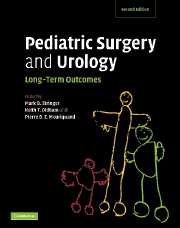Book contents
- Frontmatter
- Contents
- List of contributors
- Acknowledgments
- Preface
- Part I General issues
- Part II Head and neck
- Part III Thorax
- Part IV Abdomen
- 20 Abdominal surgery: general aspects
- 21 Abdominal wall defects
- 22 Inguinal and umbilical hernias
- 23 Infantile hypertrophic pyloric stenosis
- 24 Small bowel disorders
- 25 Cystic fibrosis
- 26 Necrotizing enterocolitis
- 27 Inflammatory bowel disease in children
- 28 Intestinal failure
- 29 Appendicitis
- 30 Hirschsprung's disease
- 31 Anorectal malformations: experience with the posterior sagittal approach
- 32 Gastrointestinal motility disorders
- 33 The Malone antegrade continence enema (MACE) procedure
- 34 Splenectomy
- 35 Biliary atresia
- 36 Choledochal cyst
- 37 Biliary stone disease
- 38 Portal hypertension
- 39 Persistent hyperinsulinemic hypoglycemia in infancy
- 40 Acute and chronic pancreatitis in children
- Part V Urology
- Part VI Oncology
- Part VII Transplantation
- Part VIII Trauma
- Part IX Miscellaneous
- Index
- Plate section
- References
32 - Gastrointestinal motility disorders
from Part IV - Abdomen
Published online by Cambridge University Press: 08 January 2010
- Frontmatter
- Contents
- List of contributors
- Acknowledgments
- Preface
- Part I General issues
- Part II Head and neck
- Part III Thorax
- Part IV Abdomen
- 20 Abdominal surgery: general aspects
- 21 Abdominal wall defects
- 22 Inguinal and umbilical hernias
- 23 Infantile hypertrophic pyloric stenosis
- 24 Small bowel disorders
- 25 Cystic fibrosis
- 26 Necrotizing enterocolitis
- 27 Inflammatory bowel disease in children
- 28 Intestinal failure
- 29 Appendicitis
- 30 Hirschsprung's disease
- 31 Anorectal malformations: experience with the posterior sagittal approach
- 32 Gastrointestinal motility disorders
- 33 The Malone antegrade continence enema (MACE) procedure
- 34 Splenectomy
- 35 Biliary atresia
- 36 Choledochal cyst
- 37 Biliary stone disease
- 38 Portal hypertension
- 39 Persistent hyperinsulinemic hypoglycemia in infancy
- 40 Acute and chronic pancreatitis in children
- Part V Urology
- Part VI Oncology
- Part VII Transplantation
- Part VIII Trauma
- Part IX Miscellaneous
- Index
- Plate section
- References
Summary
During the past decade there have been advances in the understanding of gastrointestinal (GI) motility and sensory disorders in children. Newly validated diagnostic techniques can accurately diagnose previously misunderstood patients, and progress is being made in the treatment of enteric neuromuscular disorders. In this chapter pediatric GI motility disorders are discussed according to the anatomy of the GI tract.
Esophageal disorders
The esophagus includes three functional regions: the upper esophageal sphincter (UES), the esophageal body, and the lower esophageal sphincter (LES). The UES consists of striated muscle, which relaxes in response to swallowing. The esophageal body is lined by striated muscle in the proximal third, mixed striated and smooth muscle in the middle third, and smooth muscle in the lower third. Esophageal peristalsis is initiated by swallowing and is independent of intrinsic myoelectrical activity. The coordinated motor pattern of the esophagus is called primary peristalsis. Secondary peristalsis is usually induced by luminal distention or incomplete clearance of luminal contents by primary peristalsis. This is an important mechanism for the clearance of gastric contents during gastroesophageal reflux. The lower esophageal sphincter (LES), a band of smooth muscle located at the junction of the distal esophagus and gastric cardia, is tonically contracted except during swallowing when it relaxes momentarily to allow the food bolus to pass into the stomach. Inappropriate LES relaxation independent of swallowing is the mechanism responsible for the majority of gastroesophageal reflux episodes both in adults and children.
- Type
- Chapter
- Information
- Pediatric Surgery and UrologyLong-Term Outcomes, pp. 416 - 428Publisher: Cambridge University PressPrint publication year: 2006

